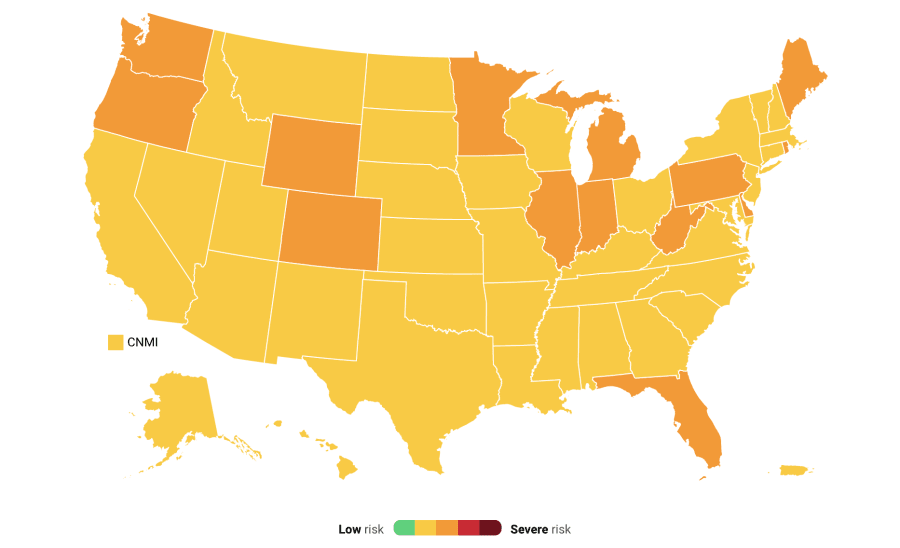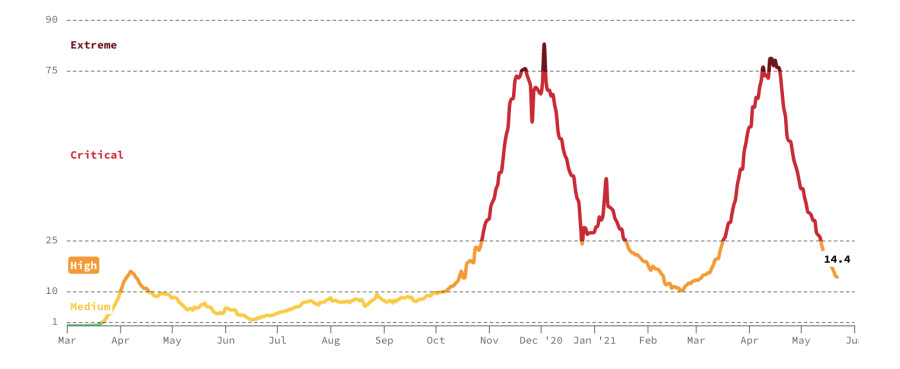For weeks, the state of Michigan was leading the nation in coronavirus spread, consistently reporting record-high numbers of daily new COVID-19 cases for 2021 throughout March and April.
As coronavirus restrictions were lifted and people were exposed to more transmissible COVID variants, Michigan experienced a surge in virus infections that resembled -- and, at times, surpassed -- the first outbreak that hit the state in the spring of 2020.
Recommended Videos
Finally, after weeks of rampant spread, the threat of COVID in Michigan has reduced as fewer people are becoming infected, and as more people get vaccinated. Michigan’s virus metrics aren’t exactly in the best shape, but they have significantly improved over the last month.
Now, as of May 24, just over a month since Michigan’s virus surge began to slow down, the state is labeled at a “high” risk for a COVID outbreak by Covid Act Now -- a group comprised of technologists, epidemiologists, health experts and public policy leaders that monitors and identifies each state’s risk level for a COVID-19 outbreak. The state’s risk level was lowered from a “very high” risk level on May 17, and was lowered from a “severe” risk level prior to that on April 22.
As one of 14 states labeled at high risk, Michigan is no longer leading the U.S. with its daily new coronavirus cases or positive test rates -- but the state’s numbers are technically still among the worst in the U.S., the data shows.
Let’s see where Michigan’s COVID metrics stand as of May 24.

Michigan’s daily new COVID-19 cases
The number of coronavirus cases being reported in Michigan each day is still among the highest in the nation.
As of May 24, Michigan is reporting 14.4 new COVID cases each day per every 100,000 residents -- or 1,435 new cases every day -- on average, according to Covid Act Now. Michigan’s rate of daily new virus cases is currently the third highest in the U.S., just behind Colorado and West Virginia.
But just because the state’s daily new case rate is among the highest in the country doesn’t necessarily mean that it’s dangerously high.
Covid Act Now considers Michigan’s case rate of 14.4 to be “high,” but that number has significantly decreased over the last several weeks.
In our last report on May 4, Michigan was reporting an average of 38 new COVID cases each day per every 100,000 residents. Prior to that, the state peaked at 78.7 daily new cases per every 100,000 residents on April 13 -- which Covid Act Now considers “extreme.”

Covid Act Now’s data largely aligns with the data reported by the state of Michigan: According to the state, Michigan has reported an average of 1,225 new COVID-19 cases each day over the last week (as of May 22).
On April 13, the state reported its highest 7-day moving average for daily cases this year: 7,014. That average rose steadily after reaching a low point in mid-February, and has been decreasing slowly since hitting that April 13 peak.
Virus infection rate in Michigan
Michigan’s COVID infection rate is actually now among the lowest in the U.S.
As of May 24, Michigan has a virus infection rate of 0.74 -- meaning that each person who contracts COVID-19 in the state is infecting, on average, 0.74 other people. The state’s infection rate is the 47th highest in the country, and is considered “low” by the research group.
“Because each person is infecting less than one other person, the total number of current cases in Michigan is shrinking,” the report reads.
The state’s current infection rate has not changed much over the last few weeks. In our last report on May 4, Michigan had a COVID infection rate of 0.78, according to Covid Act now. The state was previously leading the nation in mid-April with a high infection rate of 1.29.
States with the highest infection rates as of May 24 include Mississippi, Wyoming and Alabama who each have rates of 1.08, 1.07 and 1.02. Three weeks prior, the highest infection rate held by a state was 1.06.
Michigan’s positive COVID test rate
Yet another metric that has significantly improved in recent weeks is Michigan’s positive COVID-19 test rate.
As of May 24, Covid Act Now reports that Michigan has a positive COVID-19 test rate of about 5.3 percent -- the sixth highest rate in the United States. The research group says that Michigan’s current positive test rate “meets WHO minimums but needs to be further expanded to detect most new cases.”
Data reported by the state of Michigan shows a similar number: Over the last week, the state’s positive test rate has averaged about 5.66 percent (as of May 22), the state’s data shows.
In our last report on May 4, the state was leading the U.S. with its positive test rate of 10.2 percent. Prior to that, the state’s positive COVID test rate peaked at about 15.5 percent on April 15, and has since been slowly declining.
Health officials have previously pushed for a positive test rate of 3 percent or less, and it looks like Michigan may reach that number soon. Covid Act Now concurs, labeling test rates below 3 percent as “low.”
A positive test rate above 20 percent is considered “critical,” and the state hasn’t seen those numbers since the onset of the pandemic more than one year ago.
Other states with the highest positive COVID test rates as of May 24 are: South Dakota with 6.5 percent, West Virginia with 5.8 percent and Alabama with 5.8 percent.
Michigan vaccination, reopening progress
After rising rapidly for several weeks earlier this year, COVID-19 vaccinations are still rising each day in Michigan, just at a slower pace.
Still, the numbers are noteworthy: As of May 20, more than 57 percent of Michigan residents over the age of 16 have received at least one dose of a COVID vaccine. As of May 21, more than 47.2 percent of Michigan residents over the age of 16 are considered fully vaccinated.
The state initially had a plan to loosen coronavirus restrictions based on the percentage of Michiganders who received vaccinations against the virus. Announced at the end of April, the “MI Vacc to Normal” plan included four vaccination milestones, through which each would unlock more relaxed restrictions.
Michigan Gov. Gretchen Whitmer announced a new plan on May 20 that shortened the state’s reopening plan from four steps to two steps, neither of which have anything to do with vaccination rates. Under the new plan, Michigan’s gathering capacity limits will be loosened on June 1, and -- in addition to broad mask wearing rules -- are slated to be completely lifted on July 1.
The curfew on Michigan bars and restaurants is also slated to end on June 1.
More: Gov. Whitmer outlines Michigan’s new schedule for lifting COVID rules, getting life ‘back to normal’
Still, Michigan had reached the first milestone of the MI Vacc to Normal plan on May 10, when more than 55 percent of the state’s residents ages 16 and up had received at least their first dose of a COVID vaccine. Meeting this threshold allowed the state to resume in-person work, which had been forced remote by the pandemic, two weeks later on May 24.
The state is honoring that benchmark, and organizations have been allowed to welcome employees back to their offices on Monday.
More: Michigan announces updated workplace rules as employees return to in-person work
All throughout Michigan, COVID vaccines have begun being administered to children ages 12 and up as of May 13. The CDC backed the FDA’s authorization of the Pfizer COVID-19 vaccine for young teens earlier this month.
While new vaccinations have slowed in recent weeks in Michigan, officials hope that expanding vaccine eligibility will help increase the state’s vaccination rates.
Related: 4 data points that show how Michigan COVID surge has slowed as vaccine coverage increased



